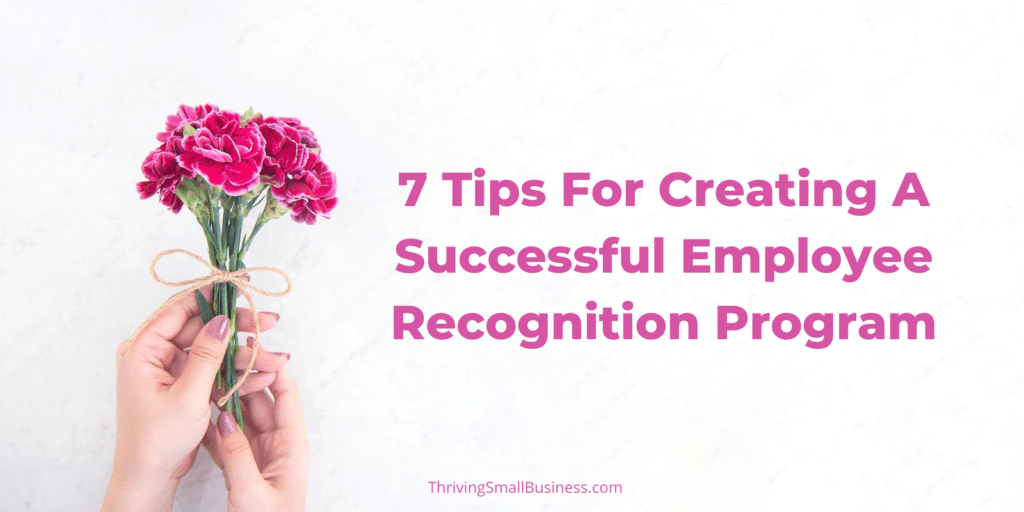7 Tips For Creating A Successful Employee Recognition Program
Estimated reading time: 7 minutes
The past several months have been an unbelievable whirlwind. If anyone had told us a year ago that we would be sheltering in place, walking around in masks, and terrified of catching a virus that no one ever heard of, we would not have believed it.
Well, here we are over six months into this year of the COVID-19 virus and still managing.
There are still millions of Americans out of work, and for those who have been fortunate enough to hang onto their jobs, work as we knew it has changed.
Employees are juggling a new work environment. Many are dealing with schooling issues with their children, and the stress of this year has been unprecedented.
As employers, we need to consider the human side of the impact of this virus and how it is impacting our most valuable asset – our employees.
Employees like to feel valued and appreciated for what they do – particularly now.
When employees commit to working for an organization, they like to feel like they are part of a team and family.
Often, they spend more time with coworkers than most other people in their lives.
It is essential to recognize the contributions employees make to an organization because it solidifies relationships, fosters employee engagement, and loyalty to the organization.
We are all wired differently, and not every social style desires public recognition.
However, even the most introverted person appreciates recognition for a job well done.
We all have a fundamental need to feel valued and loved.
I’m always amazed when I acknowledge someone’s excellent performance or, recognize something they have done, at how they smile and seem to appreciate the feedback.
Whether an employee is an introvert or an extrovert, it is vital to recognize them for their hard work.
There are two types of recognition
Informal Recognition
You don’t need to have an overly formal process to show appreciation to staff.
Spontaneous recognition can communicate a strong message of appreciation.
The closer a recognition is to performing a task, the more the employee will associate that recognition with the desired behavior.
Spontaneous recognition can be as simple as walking by an employee, observing the desired behavior, and commenting on how much you appreciate it.
These informal moments are invaluable and can reinforce an employee’s desire to do a good job.
Formal Recognition
Part of the challenge of recognizing employees is making it a priority, stopping to think about it, and doing it regularly.
Create a structure for a formal employee recognition program to ensure employees are appropriately recognized.
An employee recognition program can be as simple as designating a specific month of the year as a month that employee contributions are recognized.
Or, as structured as developing an employee-of-the-month program; or employee-of-the-year dinner.
7 Tips For Creating A Successful Employee Recognition Program
1. Assign Responsibility
Employee recognition programs are successful when someone is responsible for getting it done.
Write a job description for employee recognition or add it to a current position.
But make sure it is someone’s job to manage the process.
This person will typically be in a support role but it is their responsibility to help managers be successful at recognizing their employees.
You will often see this role in the human resource function of an organization.
2. Define The Program And Its Purpose
As with everything business, it is crucial to have very clear objectives and criteria for an employee recognition program.
Ask yourself:
Why are we doing this?
What will it look like if we are successful?
How can we ensure employees know that we appreciate them?
What criteria will we use to select an employee for recognition?
Define those areas that may warrant recognition as part of the criteria.
For instance, an employee recognition program may recognize employee tenure, an employee who made improvements to how work was done, an ability to recruit or retain customers, or personal development.

Create criteria and begin to build a program around those things that are important to the organization and its success.
3. Identify What Is Important To The Employee
We are all programmed a little differently, so keep in mind that what you might think is a great recognition may not be received the same way.
Take the time to talk to employees as you build your program. Find out what they value and build a program around that.
For instance, some employees may value a day off with a family or a preferred parking space.
Others may value a dinner gift certificate, a home improvement store gift card, or a mall gift certificate.
The ideas are endless, but the key is to find out what is important to that employee and identify a recognition gift that they would value and appreciate.
4. Train The Supervisor
Most recognition programs are as successful as the person delivering the message.
Take the time to train your supervisors and managers on why the program is important and how they can help to ensure its success.
Share with leadership the “why” behind the program so they can participate in helping to ensure its success.
5. Manage The Execution Of The Program
The implementation of a new program will have an impact on its success.
Think through the implementation and create a structured process for the rollout.
If this is your first recognition program, use that to your advantage and create a new buzz.
Develop a communication plan, so employees understand program details.
Remember, you need to communicate something between 6 and 20 times for people to remember.
So, communicate in several ways and consistently over a period of time.
Identify a date when the program will begin, so employees understand the launch date.
6. Think About The Delivery
The delivery of recognition is just as important as the gesture.
A sleepy-eyed manager who sets an envelope on an employee’s desk will not receive the same response as a manager who takes time out of a staff meeting to thank an employee publicly.
Think about the delivery as much as you do the gesture!
7. Measure Its Effectiveness
Employee recognition programs come with benefits, but these programs also come at a cost.
Recognition programs are a budget line item and need to be treated as such.
When you spend money on something, you want those dollars to count.
Take the time to measure the effectiveness of the program by utilizing data.
For instance, if you measure employee satisfaction, create a measure on your survey that will you can link satisfaction to recognition efforts.
Monitor the program every year so you can make modifications as employees and trends change.
Employee Recognition Ideas
There are lots of approaches to surprising and/or recognizing employees.
- public forums
- staff meetings
- annual employee dinners
- organization newsletters
- put a plaque on a wall
- surprising the employee at lunch
- meet them at their car at the end of the day
- a poster in the lobby
- a spot on the company website.
Get creative!
The ideas are endless, and so is the potential for creativity.
Tip: Recruit a team of front-line employees to help you
brainstorm creative ways to surprise and recognize employees.
Use your imagination and draw on the ideas of coworkers and those who know the employee best.
Some organizations sell employee recognition gift catalogs.
The gifts come in all kinds of shapes and sizes and are customized at varying price levels for budgeting purposes.
The beauty of these programs is the employee can pick out a gift they want!
Let them order their gift, and when it arrives, present it to them with a thank you!
Regardless of the recognition model you come up with, if you tell your employees what is expected of them, give them the resources to do their job,s and recognize them for a job well done, you will be well on your way to providing a great place to work and an organization that employees want to be part of!






